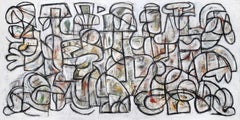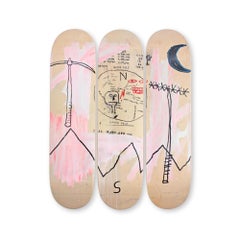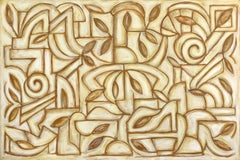JEAN-MICHEL BASQUIAT - Charles The First. Skate Decks Pop Urban Art Design
Jean-Michel Basquiat - Charles The First
Date of creation: 2024
Medium: Digital print on Canadian maple wood
Edition: Open
Size: 80 x 20 cm (each skate)
Condition: In mint conditions and never displayed
This triptych is formed by three skate decks made of 7 ply grade A Canadian maple wood.
© Estate of Jean-Michel Basquiat. Licensed by Artestar, New York
This skateboard set reproduces Charles The First (1982), a key work by Jean-Michel Basquiat that pays tribute to Charlie Parker, the influential jazz saxophonist known as "Bird." Basquiat captures the frantic energy and complexity of Parker through his signature style, blending elements of Black culture, music, and the figure of the artist in a raw and powerful representation.
The original painting, executed with acrylics, oils, and pastels, presents a stylized figure that recalls both a portrait and a symbol. The face is fragmented, filled with quick strokes and vibrant colors, while the outline and details evoke both divinity and struggle. Basquiat uses his unique visual language to convey the chaos and beauty of Parker’s life, a metaphor for creativity as a form of resistance and expression.
Transposed onto the skateboard format, Charles The First becomes a dynamic work of art that not only celebrates the life of a musical icon but also merges contemporary art with urban culture. This piece transcends simple reproduction, inviting a connection between visual art and movement in the streets, with the same vigor and attitude Basquiat infused into his work.
ABOUT THE ARTIST
Jean-Michel Basquiat (1960-1988) was one of the most influential artists of the 20th century, famous for his ability to fuse urban culture, social criticism and art history into a unique style. Born in Brooklyn, New York, to a Haitian father and Puerto Rican mother, his life and work were shaped by his multicultural heritage, the New York art scene and the social tensions of his time. Although his career was brief, his impact on contemporary art has been lasting and significant.
Basquiat showed an interest in art from an early age. His mother, Matilde Andrades, took him to museums and encouraged him to draw. At the age of seven, a car accident left him hospitalized for a time, and it was then that his mother gave him a copy of the anatomy book Gray's Anatomy, which influenced his fascination with the human body and its visual representation.
Despite his early talent, Basquiat's family life was turbulent. His mother was hospitalized for psychiatric problems and his relationship with his father, Gerard Basquiat, was troubled. This instability contributed to Basquiat dropping out of school at age 17 to pursue his artistic career on the streets of New York.
As a teenager, Basquiat joined the New York graffiti scene under the pseudonym SAMO (an acronym for "Same Old Shit"), which he used to sign his cryptic and poetic messages on the streets of Manhattan with his friend Al Diaz. SAMO's graffiti were a mixture of philosophical and social commentary on popular culture, capitalism and religion, and soon attracted the attention of the underground art scene.
In 1980, SAMO "died" when Basquiat and Diaz decided to end their collaboration, marking the beginning of Basquiat's transition from street graffiti to art galleries.
Basquiat emerged as a talent to watch in 1980, when he participated in the group exhibition The Times Square Show, which included other emerging artists from New York's Lower East Side scene. That same year, he attracted the attention of critics and collectors who saw in his work an electrifying blend of street art and neo-expressionism, the predominant movement of the time.
In 1981, art critic René Ricard published the influential essay The Radiant Child in Artforum magazine, which positioned Basquiat as one of the most promising artists of his generation. Shortly thereafter, he met renowned artist Andy Warhol, with whom he formed a close friendship and significant artistic collaboration. This association was instrumental in catapulting his career into the world of high art.
The collaboration with Warhol was a pivotal point in Basquiat's career. The two artists, although coming from very different worlds, shared a fascination with fame and popular culture. Together, they produced a series of works that combined Warhol's pop art icons with Basquiat's raw, spontaneous style.
However, this collaboration was also a source of controversy. Many critics accused Warhol of "exploiting" Basquiat, while others saw the collaboration as a creative dialogue between two genius minds. Although the criticism was mixed, there is no doubt that the relationship between the two artists helped cement Basquiat's reputation in the art world.
Basquiat's style is a unique amalgam of influences. His work is characterized by the use of dismembered human figures, skeletons and internal organs, evoking the fragility of the body and mortality. Basquiat also used symbols that alluded to African-American and African history, such as crowns, masks and references to historical figures such as Toussaint Louverture.
The use of text is another crucial aspect of his work. Words, phrases and numbers appeared in his paintings, often crossed out or overlapped, creating a sense of controlled chaos. These fragmented words provoked a non-linear reading of his works and conveyed multiple layers of meaning.
His art also reflected his concerns about racial issues, especially the place of people of African descent in Western art history and in society at large. The crowns that Basquiat often drew on his figures were a symbol of power and resistance, a way of proclaiming himself "king" in a world that had historically excluded black artists from the upper echelons of art.
In works such as The Death of
Michael Stewart...





